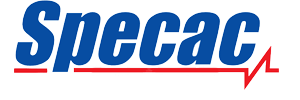Greases and lubricants are crucial to eliminate friction and ensure the smooth operation of machinery and other moving parts. However in the long run, the greases and lubricants can absorb contaminants from the machinery and degrade. This can be overcome with the performance of spectral analysis of the grease and lubricant samples.
Attenuated Total Reflectance (ATR) is a proven method employed for infrared (IR) spectral analysis of solid and liquid samples, such as solvated proteins and organic polymers. This method requires minimal sample preparation> However, to collect an IR spectrum, the physical contact of the sample with the ATR crystal needs to be good. This is not difficult for liquid samples, but solid samples have to be pressed hard onto the crystal.
This article compares the suitability of the Pearl™ Liquid Transmission Accessory (Picture 1) against the Quest™ (Picture 2) for measuring the IR spectra obtained from immobile or ‘sticky’ liquid samples, such as greases and lubricants.
.jpg)
Figure 1. The Pearl™ Liquid Transmission Accessory
.jpg)
Figure 2. The Quest™ ATR technique
Equipment and Methods
In the Pearl™, IR transmission spectra were recorded through the Oyster Cell, with wedged ZnSe windows, and a 50 µm pathlength.
ATR spectra were collected using the Quest™, equipped with an extended range diamond crystal puck and has an effective pathlength of 4.5 µm.
Tests on < 1 ml samples of DuPont Krytox LM and Castrol Gpl205 greases in undiluted condition were conducted. The spectra was recorded at a resolution of 1 cm-1 in an FTIR spectrometer. Figures 3 and 4 illustrate the absorbance traces of the Castrol Gpl205 and DuPont Krytox LM greases, respectively.
In the case of the Pearl™, the grease samples were spread over the bottom ZnSe window of the Oyster Cell, and in the Quest™, the grease samples were spread over a diamond crystal. The introduction of the sample, collection of the spectral data, and the clean-up procedure was easily and quickly completed due to the design of both pieces of equipment.
Results and Discussion
The IR absorption spectrum obtained from 3600–600 cm-1 of Castrol LM grease using the Quest™ ATR and the Pearl™ is depicted in Figure 3.
The peaks captured by the two techniques are the same, but with different resolution. As displayed, an evident difference observed from the Pearl™ is the intense absorption of light at 2900 cm-1. An additional important finding was a 10 times stronger signal intensity recorded in the Pearl™ compared to the Quest™ ATR. This illustrates roughly a 10 times longer pathlength.
.jpg)
Figure 3. Castrol LM grease spectrum, Pearl™ vs Quest™
Figure 4 illustrates the comparison of the IR absorption spectra recorded by both pieces of equipment for the DuPont Krytox grease.
As evident from both of the spectra, the weaker absorption bands within the 500–1500 cm-1 region seem to be more intense when measured with the Pearl™ accessory. While using the Quest™, the diamond crystal puck can be replaced with a Ge puck for deeper penetration of the IR beam. This increases the sample absorbance and the effective pathlength in the ATR measurement.
.jpg)
Figure 4. DuPont Krytox spectrum, Pearl™ vs Quest™
Conclusion
The Quest™ ATR and the Pearl™ Liquid Transmission Accessory were used to obtain IR absorption spectra from relatively immobile greases.
As the ATR method provides relatively shorter effective pathlengths which are dependent on the physical contact of the sample with the ATR crystal and the incident angles that are set, the spectral features recorded by the Quest™ are comparatively weaker.
As the Pearl™ provides longer effective pathlengths, the recorded spectra were largely amplified, enabling identification of vibrational modes at larger wavenumbers, like -OH or -NH molecular stretching vibrations, when compared to the ATR method.
It can be concluded that the Pearl™ provides a higher spectral resolution, even for samples with a weak IR absorption. The Pearl™ does not require a complicated spectral intensity correction. It is possible to control and determine the pathlength in the Pearl™, opposed to the Quest™. Despite this the ATR is still a highly reliable and quick method, and it is ideal for small amounts of samples with strong IR absorption.

This information has been sourced, reviewed and adapted from materials provided by Specac.
For more information on this source, please visit Specac.